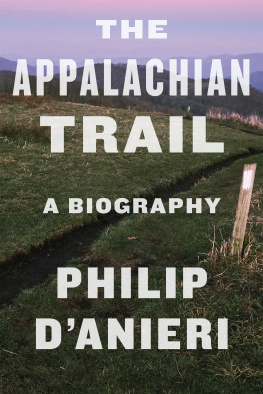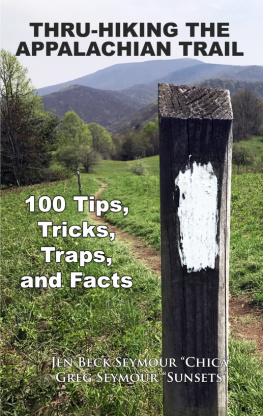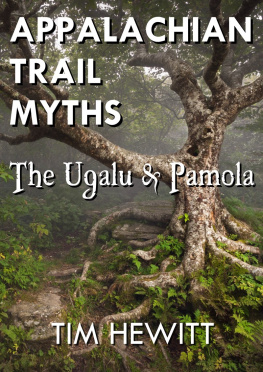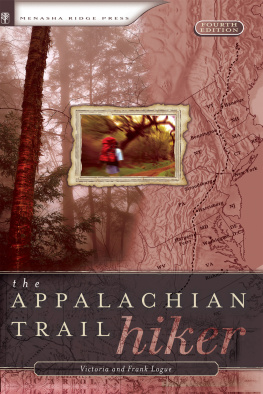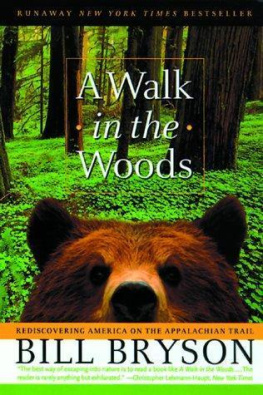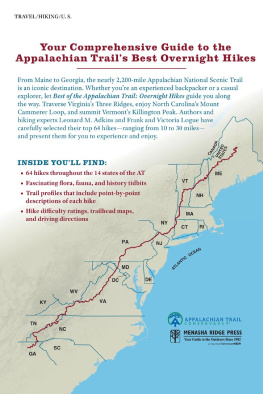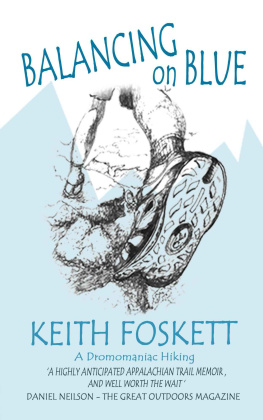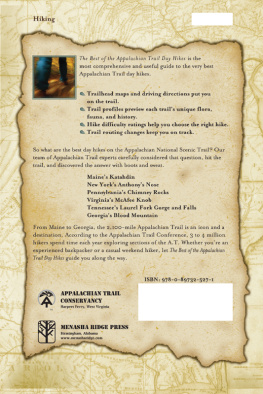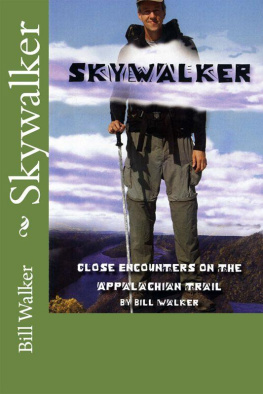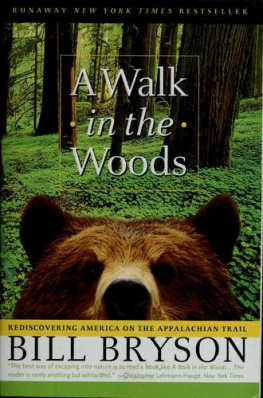Copyright 2021 by Philip DAnieri
All rights reserved
For information about permission to reproduce selections from this book, write to or to Permissions, Houghton Mifflin Harcourt Publishing Company, 3 Park Avenue, 19th Floor, New York, New York 10016.
Select excerpts from the Myron Haliburton Avery Memorial Volume and General Correspondence, and the Jean Stephenson Correspondence, used by kind permission of the Appalachian Trail Conservancy Archives.
hmhbooks.com
Library of Congress Cataloging-in-Publication Data
Names: DAnieri, Philip, author.
Title: The Appalachian Trail / Philip DAnieri.
Description: Boston : Houghton Mifflin Harcourt, 2021. | Includes bibliographical references and index.
Identifiers: LCCN 2020038416 (print) | LCCN 2020038417 (ebook) | ISBN 9780358171997 (hardcover) | ISBN 9780358449300 | ISBN 9780358449416 | ISBN 9780358169567 (ebook)
Subjects: LCSH : Appalachian TrailBiography. | Appalachian TrailHistory.
Classification: LCC F106 .D195 2021 (print) | LCC F106 (ebook) | DDC 974dc23
LC record available at https://lccn.loc.gov/2020038416
LC ebook record available at https://lccn.loc.gov/2020038417.
v1.0521
To Alicia
Introduction
Environment is the influence upon each inner mind of the thing shared by every inner mind: it is the common layer of air which we all breathethe filament which binds our separate lives.
Benton MacKaye
Beginning nearly five hundred million years ago, North America and Africa collided. Like two cars meeting head-on, both continents crumpled at the point of contact. Todays Appalachian highlandsthe mountain ranges, foothills, ridges, and valleys stretching from Atlantic Canada to the middle of Alabamaare, in the simplest possible explanation, the result of that collision. The two land masses collided repeatedly, in successive mountain-building events that geologists call orogenies. Before humans, or dinosaurs, or any land animal of any kind existed on Earth, these collisions and others brought together the supercontinent Pangea, connecting what are now North America, South America, Africa, and parts of Europe.
It was not in any way a simple process. Millions of years of mountain building were followed by millions of years of erosion, in successive cycles, as the continents crunched together in repeated orogenic pulsesthe Taconic, the Acadian, the Alleghenianuntil, one day, the tide reversed. The same roiling liquid innards of Earth that had brought the continents together split them apart again. Beginning about 250 million years ago, a rift opened and widened, creating the basin of the Atlantic Ocean, pushing North America west in a process that continues to this day. No longer on the colliding, mountain-building side of the continent (the younger, western mountains have taken over that role), the Appalachians continue their evolution in slightly less dramatic fashion.
This development of the Appalachians over eons demands of our faculties a timescale we can barely make sense of. If geologic time could somehow be seen in the perspective of human time, John McPhee writes,
sea level would be rising and falling hundreds of feet, ice would come pouring over continents and as quickly go away. Yucatans and Floridas would be under the sun one moment and underwater the next, oceans would swing open like doors, mountains would grow like clouds and come down like melting sherbet, continents would crawl like amoebae, rivers would arrive and disappear like rainstreaks down an umbrella, lakes would go away like puddles after rain, and volcanoes would light the earth as if it were a garden full of fireflies.
Its hard not to sense at some level this vastness of natures story, the smallness of our lives in the context of its massive sweep, when we go hiking in the mountains. The feeling can be both inspiring and intimidating, a fact that was clearly brought home to me one late summer day during a hike on the Appalachian Trail in western Massachusetts. My destination was that states highest point, Mt. Greylock, which, at just 3,500 feet, does not exactly rate in the pantheon of mountaineering. But then neither do I. More comfortable spending time in a library archive than a backcountry tent, I am a day-hiker onlyfive or six hours at a stretch, out and back from the comfort of a car.
This particular trip would combine town, country, and mountain, starting from the nearby community of Cheshire, one of the places where the AT jogs down a Main Street before resuming its ridgeline march from Maine to Georgia. Getting underway in the early afternoon, such that running late would mean running out of light to see with, I estimated what time the sun would set, and hoped to reach the peak with at least half my time remaining.
The trail led out of town past the local elementary school, through a cornfield, into the woods, and up a moderately steep ascent. As I walked, a pleasant sense of separation from the world settled in, the subtly altered mental state that is in my mind the main reason to go for a hike. Its not just the physical change of scenery, or even the literal change in perspective that is sometimes afforded from a lookout. Its a more figurative change in viewpoint, the hiker reduced to a world with basically two directions, forward and back. Its the adjustment of our sense of time and distance to walking scale, and the knowledge that only physical effort, rather than a press on the accelerator or a click on the screen, can change the view.
Physical effort, indeed. This trail was accomplishing a fair bit of vertical in the space of not very much horizontal. Only an hour or so into the hike, I was winded, sweating a fair bit, mildly alarmed by the first sensations of queasiness. It occurred to me, with the 20-20 hindsight that not only clarifies but embarrasses, that the total height of a mountain has very little to do with the distance and change in elevation of any particular hike. Sure, Greylock is shorter than other mountains Id stood on top of. But how high were those starting trailheads? And how gradual was the ascent?
The situation was made worse by the fact that I had no water to drink. It was August, after all, and the moisture that was soaking through my shirt seemed to come directly from my increasingly dry mouth. This was an inexcusable oversight, an overreaction to my years of suburban fatherhood, in which every activity a kid engaged in seemed to be shadowed by a parent waving a disposable water bottle in the young ones direction. Sometimes it seemed a wonder that I had survived my own youth without a parental water source at my elbow. Those serious hikers who overnight on the trail, for days or weeks or months, they needed to think seriously about water. Schlubby old me, out for an afternoon excursion? Shrug.
Mistake.
I pressed on up the trail, my discomfort growing and confidence waning. The internal conversation cycled rapidly between Pull yourself together, this is Massachusetts, not Tibet and Ive made a terrible mistake. During frequent breaks I would consult the trail map and try to gauge the distance and time remaining. When there were about forty-five minutes to go before the halfway mark, the map indicated there was about that much time left to the summit. I was at the top of a lower, neighboring peak, Saddle Ball, presumably named for its position at the opposite end of a saddle shape from Greylock. Reaching the goal would mean walking the saddle down into the gap between the two summits and up to the top of Greylock. If my calculations were right, Id barely make it in time, and have to immediately turn around to make it out of the woods before dark. A trip that was already closer to safety limits, in terms of exertion, time of day, and hydration, than was prudently advisable would be pushed even closer.

